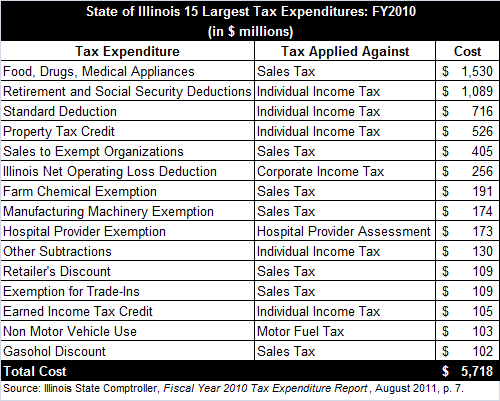September 22, 2011
The Illinois State Comptroller’s Office recently issued its annual report on tax expenditures. The report is published pursuant to a provision of the State Comptroller Act (15 ILCS 405/16) that requires the Comptroller’s Office to collect tax expenditure information reported by state agencies.
A tax expenditure is defined in the State Comptroller Act as any exemption, exclusion, deduction, allowance, credit, preferential tax rate, abatement or other device that reduces the amount of tax revenue that would otherwise accrue to the State. Tax expenditures are available to both individuals and businesses and are commonly referred to as tax breaks. They are intended to benefit selected groups, such as the elderly, or to provide an incentive for the performance of desired activities, such as encouraging economic development.
In FY2010 tax expenditures reduced State of Illinois revenues by $6.594 billion, according to the Comptroller’s latest report. To put tax expenditures in context, general operating revenues from state taxes and fees totaled $21.2 billion in FY2010.
Tax expenditures of $6.594 billion in FY2010 declined slightly from $6.627 billion in FY2009 but have more than doubled from $3.1 billion in FY1993, the first year the report was issued. The growth in the value of tax expenditures from FY1993 to FY2010 reflects improved reporting, new tax expenditures and the impact of inflation and economic growth.
Although 238 tax expenditures were identified in FY2010, the three largest cost the State $3.335 billion and accounted for just over half of the total cost. The largest tax expenditure at $1.53 billion involved the reduced sales tax rate for food, drugs and medical appliances. The state sales tax rate on general merchandise is 6.25%. The state keeps 5% of the purchase price and pays the remaining 1.25% to local governments. However, the state sales tax rate on groceries, medicines and medical appliances is 1% and all of the tax revenues go to local governments.
The deduction for retirement income ($1.089 billion) and standard deduction ($716 million) were the second and third most expensive tax expenditures in FY2010. Retirement income such as Social Security payments and income from Individual Retirement Accounts is taxed by the federal government but not by Illinois. The standard deduction allowance from the state individual income tax is $2,000 for a single taxpayer.
In FY2010 there were 15 tax expenditures that cost more than $100 million. The chart below shows the largest 15 tax expenditures, which had a combined cost of $5.718 billion or 86.7% of the total of $6.594 billion. As shown in the chart, the four top tax expenditures were for individuals, rather than businesses.

Illinois is one of 44 states that produce some form of tax expenditure report, according to a study in May 2011 by the Center on Budget and Policy Priorities. Oregon, Minnesota and the District of Columbia publish the most comprehensive and informative reports, according to the study.
